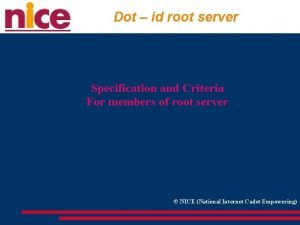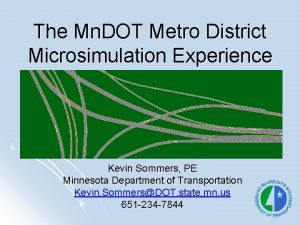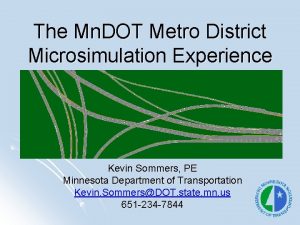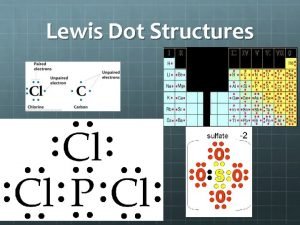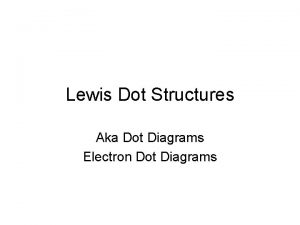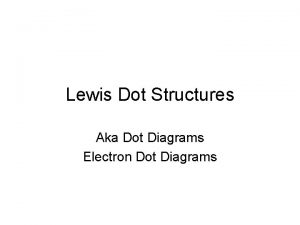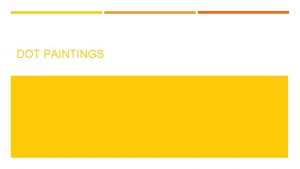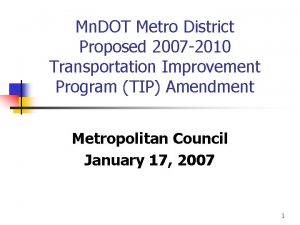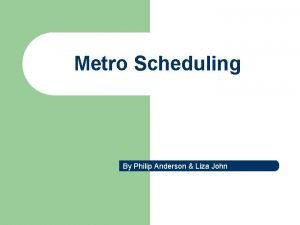The Mn DOT Metro District Microsimulation Experience Kevin












- Slides: 12

The Mn. DOT Metro District Microsimulation Experience Kevin Sommers, PE Minnesota Department of Transportation Kevin. Sommers@DOT. state. mn. us 651 -234 -7844

In the Beginning…. Models were developed according to user preferences. l Several items considered optional including model calibration. l Typical model was 1 time period of 60 minutes without origin-destination data. l Reported values based on a single run of model. l

CORSIM Training Manual l Developed By Mn/DOT & FHWA to: Ø Clarify modeling process. Ø Produce reusable and verifiable products. Ø Meet Federal operational analysis requirements for the Interstate Access Request.

CORSIM Training Manual l Lists 21 items to be followed on all modeling projects. l Categories: Ø Model Requirements Ø Data Requirements Ø Calibration Requirements Ø Quality Control Requirements

CORSIM Training Manual l Lists 11 required deliverables. l The most critical are: Ø Link-Node Diagrams. Ø Lane Schematics. Ø QA/QC Sheets. Ø O-D Matrixes. Ø Balanced Traffic Demand Dataset. Ø MOE Tables.

The Freeway Lane Schematic l l Graphical representation of freeway made modeling results easier to understand. Color is used to highlight congested sections.

Design Selection l l l Typically several designs developed for a freeway corridor. 2, 3, or 4 design options are tested using microsimulation to determine best option. Design Options Ø TH 610 at I-94 § Ø Partial Build vs. Full Build TH 169 at I-494 § Ring Road System (3 designs)

Design Selection l Interchange Type Ø I-494 at Lyndale Ave. § l Traffic Control Ø TH 610 at Zachary Lane § l Single Point vs. Tight Diamond Signals vs. Roundabouts Collector-Distributor Roads Ø I-35 E at CSAH 14 § Connect SB entry ramps to CD Road or Interstate

Tweaking the Design l Sometimes the accepted design needs a little help. l Auxiliary Lanes Ø I-35 at CSAH 70 § l Auxiliary Lane Between CSAH 70 and CSAH 60 Turn Bays Ø TH 62 at I-494 § Dual Left vs. Triple Left

Freeways Modeled To Date l Ø Ø Ø Ø 210 miles of freeway modeled including: 40 miles of I-35 W 31 miles of I-494 28 miles of I-94 16 miles of I-694 14 miles of I-35 E 10 miles of I-35 10 miles of I-394

Modeling Website l l l Advanced CORSIM Manual Freeway Modeling Workshop Presentations Modeling Resource Materials FHWA Traffic Analysis Toolbox Link to Mn. DOT Data Extraction Tools Link to Mn. DOT Turning Movement Information http: //www. dot. state. mn. us/trafficeng/modeling/index. html

Thank You
 192 dot 168 dot 1 dot 1
192 dot 168 dot 1 dot 1 Mndot metro district
Mndot metro district Imprinting meaning psychology
Imprinting meaning psychology Early experience vs later experience
Early experience vs later experience Indirect experience
Indirect experience Dot net vs dot com
Dot net vs dot com Assignment 9 solving inequalities
Assignment 9 solving inequalities Cong thức tính động năng
Cong thức tính động năng Thế nào là mạng điện lắp đặt kiểu nổi
Thế nào là mạng điện lắp đặt kiểu nổi Dạng đột biến một nhiễm là
Dạng đột biến một nhiễm là Thế nào là sự mỏi cơ
Thế nào là sự mỏi cơ Bổ thể
Bổ thể Vẽ hình chiếu đứng bằng cạnh của vật thể
Vẽ hình chiếu đứng bằng cạnh của vật thể
